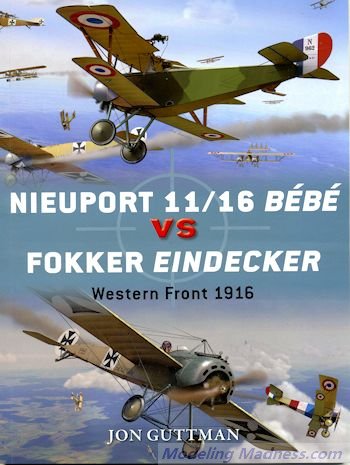 Much of what
has been written about the air war during WWI concentrates on the last year or
two of the war. Not surprising as that is very much a time when air to air
combat came to prominence. There were more planes in the air during those years
and these were the planes that draw the most interest. Albatros D.III, Sopwith
Camel, Spad XIII, Fokker D.VII and others of that time are what will most come
to mind.
Much of what
has been written about the air war during WWI concentrates on the last year or
two of the war. Not surprising as that is very much a time when air to air
combat came to prominence. There were more planes in the air during those years
and these were the planes that draw the most interest. Albatros D.III, Sopwith
Camel, Spad XIII, Fokker D.VII and others of that time are what will most come
to mind.
But all these planes had to have a starting place. and so it
was during late 1915. Prior to this time, the main purpose of aircraft was
reconnaissance and scouting. Most planes were two seat aircraft with a pilot and
an observer. They were to fly over the trenches to see where things were and to
take photos. Sometimes they were also use to spot for artillery. Meetings
between opposing sides were accidental at best and little effort was used to
disrupt the other's mission. Of course, not all felt that way and slowly each
side sent aircraft in the air with the purpose of shooting down the other's
recce birds and preventing them from gaining the sort of intelligence they
sought.
From all of this evolved the single engine pursuit plane,
whose lone purpose was to shoot down other planes. The first really successful
aircraft of this type was the Fokker Eindekker. This was a monoplane that used
wing warping to help turn the plane. What it had that others did not was a
successful interrupter gear that allowed a centrally mounted machine gun to fire
straight ahead without shooting off the prop. Before this, the French had
installed steel wedges on the prop to deflect the bullet, though this wasn't the
best way to do things.
Thanks to this piece of technology, all the pilot had to do
was to point the plane and shoot. Thus began what was known as the 'Fokker
Scourge'. It made household names of people like Immelmann and Boelke. However,
such was the pace of aviation technology that what was the best became the
second-best in but a few months. This was due to the development of the Nieuport
11 'Bebe' followed by the more powerful Nieuport 16. Here was a small sequiplane
that was light and maneuverable. Though without the interrupter gear and having
to mount their Lewis gun atop the wing to prevent shooting off the prop, the
Nieuport allowed French and British pilots to outmaneuver and out-run the Fokker
Eindekkers. Soon the tables had turned and the Scourge was quickly no more. Of
course, this only lasted until the Albatros scouts showed up a few months later,
but that is outside the scope of this book.
Typical of the series, we get a full background of the
tactical and strategic situation of the time period. We also look at the
development of the two aircraft and how these planes changed the way tactics
were developed for what was basically a new type of aircraft. It also covers the
operational use of these planes as well as some of the luminaries associated
with each type. We get to see which pilots on each side were most successful
against the other's aircraft. Thanks to the superiority of the Nieuport, more
Bebe pilots scored against Eindekkers than the other way around. Interestingly,
the battles against each other are quite minimal as most pilots of the time
scored against the slower two seat planes. All of this is enhanced by some great
period photos as well as some superbly done artwork.
An excellent book that tells a story not often heard. It
makes for a great read and reference. Highly recommended for the WWI buff and
aviation enthusiast.
June 2014
For more on the complete line of Osprey books,
visit www.ospreypublishing.com. In the US, it is
Osprey Direct at 443 Park Avenue South, New York, NY 10016, where you can
get a catalogue of available books.
If you would like your product reviewed fairly and quickly, please contact
me or see other details in the Note to
Contributors.
 Much of what
has been written about the air war during WWI concentrates on the last year or
two of the war. Not surprising as that is very much a time when air to air
combat came to prominence. There were more planes in the air during those years
and these were the planes that draw the most interest. Albatros D.III, Sopwith
Camel, Spad XIII, Fokker D.VII and others of that time are what will most come
to mind.
Much of what
has been written about the air war during WWI concentrates on the last year or
two of the war. Not surprising as that is very much a time when air to air
combat came to prominence. There were more planes in the air during those years
and these were the planes that draw the most interest. Albatros D.III, Sopwith
Camel, Spad XIII, Fokker D.VII and others of that time are what will most come
to mind.